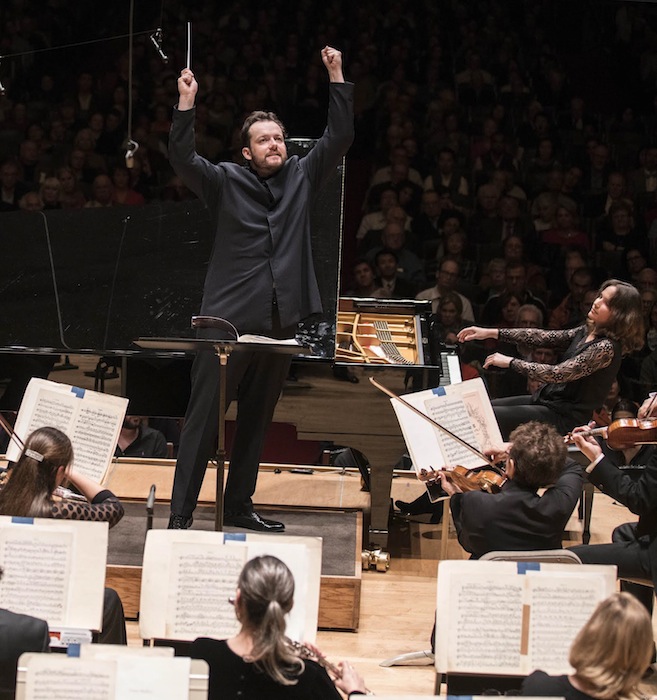Nelsons, BSO bring out the drama and serenity of late Brahms works

Helene Grimaud performed Brahms’ Piano Concerto No. 2 with Andris Nelsons and the Boston Symphony Orchestra Tuesday night. Photo: Marco Borggreve
Of all of the photographs of Brahms, two stand out. One dates from 1853. The composer, at twenty years old, is handsome with long hair combed back to reveal his clean-shaven face. The other dates from 1890, and shows the Brahms of legend. He is portly and sports a heavy beard. But the eyes are penetrating and his face betrays hints of youthful tenderness.
The composer’s Second Piano Concerto and Third Symphony date from the early 1880s at a time when Brahms became the more private and thoughtful figure captured in the second photograph. As a composer, Brahms had come into his own, and these works are filled with contemplative lines and introspective musical statements.
Both pieces were heard Tuesday night at Symphony Hall, where Andris Nelsons and the Boston Symphony Orchestra continued their traversal of Brahms’ complete piano concertos and symphonies.
The Second Concerto is expansive in scale, largely lacking the impetuous virtuosity of the First. Instead, the work shows Brahms at his delicate finest and brims with mellifluous lines and melodic tenderness. French pianist Hélène Grimaud, who performed as soloist Tuesday night, has called the piece “an elaborate memoir” of Brahms’ innermost thoughts.
Grimaud is a pianist of extremes. She possesses a sturdy technique and soft, elegant touch where the music calls for it. Yet she isn’t afraid to attack the keyboard and draw forceful statements in the fuller sections of the piece.
In her hands, the phrases of the concerto unfolded in grand arches of sound. The first movement was dramatic. Grimaud’s playing was muscular, her tone resonant in the heavier sections of the piece. There was clarity to her playing. Passages sounded with crystalline precision.
Pianists and conductors differ on how to interpret the second movement and that was the case Tuesday night. Grimaud opted for a powerful rendition of the opening figure, while Nelsons coaxed smooth accompaniment from the descending and pulsing octaves in the strings. Grimaud’s touch was a little more percussive than it needed to be, and there was not always a unifoimity of style between soloist and ensemble.
The third movement, though, featured Grimaud in soft elegance and her playing took on a feathery delicacy in the quiet passages. Her dialogue with solo cello, played with silver tone by Martha Babcock, was particularly beautiful. In the fourth movement, Grimaud’s playing had a Mozartean grace. Nelsons led with quick tempos that gave the music a bright energy.
That same breadth of expression characterized Nelsons’ rendition of the Third Symphony.
With this piece, Brahms finally threw off the shackles of Beethoven. The work is thoroughly lyrical and less dramatic when compared with the tragic-heroic thrust of the First.
Nelsons has proven to be a committed Brahmsian and led with a clear eye to the composer’s singing lines. The sweeping opening theme was put across with surging vitality, and the phrases of the second theme flowed like water in a stream.
The remarkable feature of this performance was Nelsons’ careful attention to musical phrases, which he crafted in a vocal arc. The waltz of the third movement moved in waves, while the theme of the second movement meandered gently in its soft woodwind lines.
Most of the drama was saved for the final movement, where the coiling theme broke into statements of stark power. The syncopated figures and brass calls had bite and force when necessary. An echo of the symphony’s opening theme came to rest on a warm brass chord, which brought a golden end to the work.
Concerts of the last two weeks have spotlighted new pieces. Last week featured the world premiere of Eric Nathan’s the shape of a door, and Tuesday night Nelsons led a committed account of Timo Andres’ Everything Happens So Much.
In the past few years, Andres has crashed onto the classical music scene like a meteor with music of driving intensity, crystalline technique and form, and broad appeal. That’s certainly the case with his latest work. As its title suggests, Everything Happens So Much brims with musical ideas, and the eleven-minute piece is rife with restless energy and dynamic orchestral color.
Andres’ music owes something to the driving post-minimalism of John Adams. His harmonic language is tonal, though structurally the work is pieced together from gestures of melody, as if a Brahms theme were fractured beyond recognition.
The work opens with a playful theme in the piccolo that quickly spreads to oboe and clarinet. As more instruments enter the fray, the texture becomes thorny and abuzz with intensity. Melodies cross each other in unusual ways, creating punchy, syncopations that pulse like Morse code.
Moreover, Everything Happens So Much is a dialogue of textures. Serene harmonies held by the strings frame fragmented statements from piccolo, harp, and percussion. By work’s end, the strings break into soaring phrases. Yet the motion is glacial, and chords turn in space like a prism that catches the light at every angle. Given the BSO’s evocative and energetic reading, Andres is a composer with something to say, and he says it well.
The program will be repeated 8 p.m. Thursday at Symphony Hall. Brahms’ Fourth Symphony will be heard along with the concerto and Andres’ piece 8 p.m. Friday and Saturday at Symphony Hall. bso.org; 888-266-1200.
Posted in Performances



